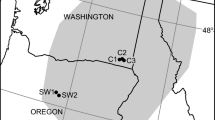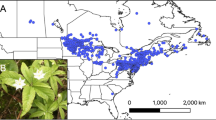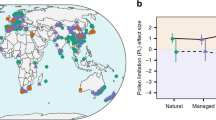Abstract
Predicting demographic consequences of climate change for plant communities requires understanding which factors influence seed set, and how climate change may alter those factors. To determine the effects of pollen availability, temperature, and pollinators on seed production in the alpine, we combined pollen-manipulation experiments with measurements of variation in temperature, and abundance and diversity of potential pollinators along a 400-m elevation gradient. We did this for seven dominant species of flowering plants in the Coast Range Mountains, British Columbia, Canada. The number of viable seeds set by plants was influenced by pollen limitation (quantity of pollen received), mate limitation (quality of pollen), temperature, abundance of potential pollinators, seed predation, and combinations of these factors. Early flowering species (n = 3) had higher seed set at high elevation and late-flowering species (n = 4) had higher seed set at low elevation. Degree-days >15 °C were good predictors of seed set, particularly in bee-pollinated species, but had inconsistent effects among species. Seed production in one species, Arnica latifolia, was negatively affected by seed-predators (Tephritidae) at mid elevation, where there were fewer frost-hours during the flowering season. Anemone occidentalis, a fly-pollinated, self-compatible species had high seed set at all elevations, likely due to abundant potential pollinators. Simultaneously measuring multiple factors affecting reproductive success of flowering plants helped identify which factors were most important, providing focus for future studies. Our work suggests that responses of plant communities to climate change may be mediated by flowering time, pollination syndrome, and susceptibility to seed predators.



Similar content being viewed by others
References
Ashman T-L, Knight TM, Steets JA, Amarasekare P, Burd M, Campbell DR, Dudash MR, Johnston MO, Mazer SJ, Mitchell RJ, Morgan MT, Wilson WG (2004) Pollen limitation of plant reproduction: ecological and evolutionary causes and consequences. Ecology 85:2408–2421. doi:10.1890/03-8024
Barnett DT, Stohlgren TJ (2003) A nested-intensity design for surveying plant diversity. Biodivers Conserv 12:255–278. doi:10.1023/A:1021939010065
Bray JR, Curtis JT (1957) An ordination of the upland forest communities of Southern Wisconsin. Ecol Monogr 27:325–349. doi:10.2307/1942268
Brosi BJ, Briggs HM (2013) Single pollinator species losses reduce floral fidelity and plant reproductive function. Proc Natl Acad Sci 110(13044):13048. doi:10.1073/pnas.1307438110
Burd M (1994) Bateman’s principle and plant reproduction: the role of pollen limitation in fruit and seed set. Bot Rev 60:83–139. doi:10.1007/BF02856594
Clarke KR (1993) Non-parametric multivariate analyses of changes in community structure. Aust J Ecol 18:117–143. doi:10.1111/j.1442-9993.1993.tb00438.x
Cooper EJ, Dullinger S, Semenchuk P (2011) Late snowmelt delays plant development and results in lower reproductive success in the high Arctic. Plant Sci 180:157–167. doi:10.1016/j.plantsci.2010.09.005
Dafni A, Kevan PG, Husband BC (2005) Practical pollination biology. Enviroquest, Cambridge
Darwin C (1862) On the various contrivances by which British and foreign orchids are fertilised by insects: and on the good effects of intercrossing. Murray, London
Droege S, Tepedino VJ, Lebuhn G, Link W, Minckley RL, Chen Q, Conrad C (2010) Spatial patterns of bee captures in North American bowl trapping surveys. Insect Conserv Divers 3:15–23. doi:10.1111/j.1752-4598.2009.00074.x
Dunne JA, Harte J, Taylor KJ (2003) Subalpine meadow flowering phenology responses to climate change: integrating experimental and gradient methods. Ecol Monogr 73:69–86. doi:10.1890/0012-9615(2003)073%5B0069:SMFPRT%5D2.0.CO;2
Ehrlén J (1992) Proximate limits to seed production in a herbaceous perennial legume, Lathyrus vernus. Ecology 73:1820–1831. doi:10.2307/1940033
Fabbro T, Körner C (2004) Altitudinal differences in flower traits and reproductive allocation. Flora Morphol Distrib Funct Ecol Plants 199:70–81. doi:10.1078/0367-2530-00128
Forrest J (2011) Plant-pollinator interactions in a changing climate. PhD dissertation, Department of Ecology and Evolutionary Biology, University of Toronto, Toronto, Ontario, Canada
Forrest J, Thomson JD (2009) Pollinator experience, neophobia and the evolution of flowering time. Proc R Soc B 276:935–943. doi:10.1098/rspb.2008.1434
Forrest J, Thomson JD (2011) An examination of synchrony between insect emergence and flowering in Rocky Mountain meadows. Ecol Monogr 81:469–491. doi:10.1890/10-1885.1
Galen C, Stanton ML (1993) Short-term responses of alpine buttercups to experimental manipulations of growing season length. Ecology 74(4):1052–1058 doi:10.2307/1940475
García-Camacho R, Totland Ø (2009) Pollen limitation in the alpine: a meta-analysis. Arct Antarct Alp Res 41:103–111. doi:10.1657/1523-0430-41.1.103
Gutierrez A, Ponti L, d’Oultremont T, Ellis C (2008) Climate change effects on poikilotherm tritrophic interactions. Clim Change 87:167–192. doi:10.1007/s10584-007-9379-4
Haig D, Westoby M (1988) On limits to seed production. Am Nat 131:757–759. Article Stable: http://www.jstor.org/stable/2461676
Hedges LV, Gurevitch J, Curtis PS (1999) The meta-analysis of response ratios in experimental ecology. Ecology 80:1150–1156. doi:10.1890/00129658(1999)080%5B1150:TMAORR%5D2.0.CO2
Hegland SJ, Nielsen A, Lázaro A, Bjerknes AL, Totland Ø (2009) How does climate warming affect plant–pollinator interactions? Ecol Lett 12:184–195. doi:10.1111/j.14610248.2008.01269.x
Hodkinson ID (2005) Terrestrial insects along elevation gradients: species and community responses to altitude. Biol Rev 80:489–513. doi:10.1017/S1464793105006767
Hothorn T, Zeileis A, Millo G, Mitchell D (2012) lmtest: testing linear regression models. R project.org
Hülber K, Winkler M, Grabherr G (2010) Intraseasonal climate and habitat-specific variability controls the flowering phenology of high alpine plant species. Funct Ecol 24:245–252. doi:10.1111/j.1365-2435.2009.01645.x
Inouye DW (2008) Effects of climate change on phenology, frost damage, and floral abundance of montane wildflowers. Ecology 89:353–362. doi:10.1890/06-2128.1
Inouye DW, Barr B, Armitage KB, Inouye BD (2000) Climate change is affecting altitudinal migrants and hibernating species. PNAS 97:1630–1633. doi:10.1073/pnas.97.4.1630
Inouye D, Morales M, Dodge G (2002) Variation in timing and abundance of flowering by Delphinium barbeyi; Huth (Ranunculaceae): the roles of snowpack, frost, and La Niña, in the context of climate change. Oecologia 130:543–550. doi:10.1007/s00442-001-0835-y
Kearns CA, Inouye DW (1993) Techniques for pollination biologists. University Press of Colorado, Niwot
Kearns CA, Inouye DW (1994) Fly pollination of Linum lewisii (Linaceae). Am J Bot 81:1091–1095. doi:10.2307/2445470
Knight TM, Steets JA, Vamosi JC, et al. (2005) Pollen limitation of plant reproduction: pattern and process. Annu Rev Ecol Evol Syst 36:467–497. doi:10.1146/annurev.ecolsys.36.102403.115320
Krebs CJ, Boonstra R, Cowcill K, Kenney AJ (2009) Climatic determinants of berry crops in the boreal forest of the southwestern Yukon. Botany 87:401–408. doi:10.1139/B09-013
Kudo G, Hirao A (2006) Habitat-specific responses in the flowering phenology and seed set of alpine plants to climate variation: implications for global-change impacts. Popul Ecol 48:49–58. doi:10.1007/s10144-005-0242-z
Kudo G, Nishikawa Y, Kasagi T, Kosuge S (2004) Does seed production of spring ephemerals decrease when spring comes early? Ecol Res 19:255–259. doi:10.1111/j.14401703.2003.00630.x
Larson BMH, Barrett SCH (2000) A comparative analysis of pollen limitation in flowering plants. Biol J Linn Soc 69:503–520. doi:10.1111/j.10958312.2000.tb01221.x
Lee TD, Bazzaz FA (1982) Regulation of fruit and seed production in an annual legume, Cassia fasciculata. Ecology 63:1363–1373. doi:10.2307/1938864
Marshall SA (2006) Insects: their natural history and diversity: with a photographic guide to insects of eastern North America. Firefly, Buffalo
McCall C, Primack RB (1992) Influence of flower characteristics, weather, time of day, and season on insect visitation rates in three plant communities. Am J Bot 79:434–442. doi:10.2307/2445156
Motten AF (1986) Pollination ecology of the spring wildflower community of a temperate deciduous forest. Ecol Monogr 56:21–42. doi:10.2307/2937269
Pojar J (1974) Reproductive dynamics of four plant communities of southwestern British Columbia. Can J Bot 52:1819–1834. doi:10.1139/b74-234
Price MV, Waser NM (1998) Effects of experimental warming on plant reproductive phenology in a subalpine meadow. Ecology 79:1261–1271. doi:10.2307/176741
Rafferty NE, Ives AR (2012) Pollinator effectiveness varies with experimental shifts in flowering time. Ecology 93:803–814. doi:10.1890/11-0967.1
Rafferty NE, CaraDonna PJ, Burkle LA, et al. (2013) Phenological overlap of interacting species in a changing climate: an assessment of available approaches. Ecol Evol 3:3183–3193. doi:10.1002/ece3.668
Scheidel U, Röhl S, Bruelheide H (2003) Altitudinal gradients of generalist and specialist herbivory on three montane Asteraceae. Acta Oecol 24:275–283. doi:10.1016/j.actao.2003.09.004
Schemske DW (1977) Flowering phenology and seed set in Claytonia virginica (Portulacaceae). Bull Torrey Bot Club 104:254–263. doi:10.2307/2484307
Straka JR, Starzomski BM (2014) Humming along or buzzing off? The elusive consequences of plant-pollinator mismatches. J Pollinat Ecol [Suppll] 13, Available at: http://www.pollinationecology.org/index.php?journal=jpe&page=article&op=view&pah%5B%5D=221
Thomson JD (2010) Flowering phenology, fruiting success and progressive deterioration of pollination in an early-flowering geophyte. Philos Trans R Soc B Biol Sci 365:3187–3199. doi:10.1098/rstb.2010.0115
Thórhallsdóttir TE (1998) Flowering phenology in the central highland of Iceland and implications for climatic warming in the Arctic. Oecologia 114:43–49. doi:10.1007/s004420050418
Totland Ø (1994) Influence of climate, time of day and season, and flower density on insect flower visitation in alpine Norway. Arct Alp Res 26:66–71. doi:10.2307/1551879
Totland Ø (1997) Limitations on reproduction in alpine Ranunculus acris. Can J Bot 75:137–144. doi:10.1139/b97-016
Totland Ø (2001) Environment-dependent pollen limitation and selection on floral traits in an alpine species. Ecology 82:2233–2244. doi:10.2307/2680228
Triplehorn CA, Johnson NF, Borror DJ (2005) Borror and DeLong’s introduction to the study of insects. Thompson Brooks/Cole, Belmont
Vander Kloet SP (1988) The genus Vaccinium in North America. Research Branch Agriculture Canada, Ottawa
Vuong QH (1989) Likelihood ratio tests for model selection and non-nested hypotheses. Econometrica 57:307–333. doi:10.2307/1912557
Willmer P (2012) Ecology: pollinator–plant synchrony tested by climate change. Curr Biol 22:R131–R132. doi:10.1016/j.cub.2012.01.009
Zeileis A, Kleiber C, Jackman S (2008) Regression models for count data in R. J Stat Softw 27:1–25 http://www.jstatsoft.org/v27/i08
Acknowledgments
Funding was provided by the Natural Sciences and Engineering Research Council of Canada, the Pacific Institute for Climate Solutions, and the University of Victoria. Two anonymous reviewers provided comments that greatly improved the manuscript. We thank Luise Hermanutz, Andrew Trant, Kimberly Carlson, Kira Hoffman, and Katharine Baldwin-Corriveau for comments on earlier versions. Andrew Sheriff and Erika Dort were instrumental in completing the field work. The experiments comply with the current laws of the country (Canada) in which the experiments were performed.
Author information
Authors and Affiliations
Corresponding author
Additional information
Communicated by John Thomas Lill.
Electronic supplementary material
Below is the link to the electronic supplementary material.
Rights and permissions
About this article
Cite this article
Straka, J.R., Starzomski, B.M. Fruitful factors: what limits seed production of flowering plants in the alpine?. Oecologia 178, 249–260 (2015). https://doi.org/10.1007/s00442-014-3169-2
Received:
Accepted:
Published:
Issue Date:
DOI: https://doi.org/10.1007/s00442-014-3169-2




